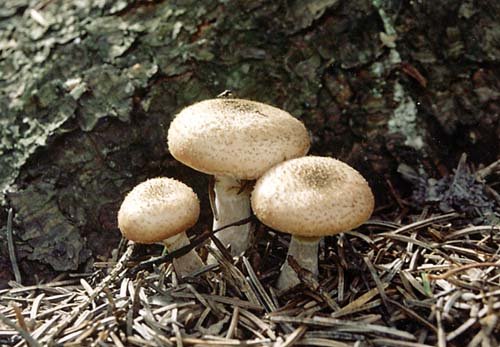Thick-legged honey agaric (Armillaria gallica)
- Division: Basidiomycota (Basidiomycetes)
- Subdivision: Agaricomycotina (Agaricomycetes)
- Class: Agaricomycetes (Agaricomycetes)
- Subclass: Agaricomycetidae (Agaricomycetes)
- Order: Agaricales (Agaric or Lamellar)
- Family: Physalacriaceae (Physalacriae)
- Genus: Armillaria (Agaric)
- Type: Armillaria gallica (Mushroom thick-legged)
- Armillary bulbous
- Armillary lute
- Mushroom bulbous

Honey agaric thick-legged (lat. French armorial bearings) is a mushroom species included in the genus Armillaria of the Physalacriaceae family.
Hat:
The diameter of the cap of the thick-legged honey agaric is 3-8 cm, the shape of young mushrooms is hemispherical, with a wrapped edge, with age it opens to almost prostrate; the color is indefinite, on average rather light, greyish-yellow. Depending on the place of growth and characteristics of the population, there are both almost white and rather dark specimens. The hat is covered with small dark scales; as they mature, the scales migrate to the center, leaving the edges almost smooth. The flesh of the cap is white, dense, with a pleasant “mushroom” smell.
Records:
Slightly descending, frequent, at first yellowish, almost white, turning buffy with age. In overripe mushrooms, characteristic brown spots are visible on the plates.
Spore powder:
White.
Leg:
The length of the leg of the thick-legged honey agaric is 4-8 cm, diameter is 0,5-2 cm, cylindrical in shape, usually with a tuberous swelling at the bottom, lighter than the cap. In the upper part – the remains of the ring. The ring is white, cobwebbed, tender. The flesh of the leg is fibrous, tough.
Spread:
The thick-legged honey agaric grows from August to October (sometimes it also occurs in July) on rotting tree remains, as well as on the soil (especially on spruce litter). Unlike the dominant species Armillaria mellea, this species, as a rule, does not affect living trees, and it does not bear fruit in layers, but constantly (though not so abundantly). It grows in large groups on the soil, but, as a rule, does not grow together in large bunches.
Similar species:
This variety differs from the “basic model” called Armillaria mellea, firstly, by the place of growth (mainly forest floor, including coniferous, less often stumps and dead roots, never living trees), and secondly, by the shape of the stem ( often, but not always found, characteristic swelling in the lower part, for which this species was also called Armillary bulbous), and thirdly, a special “cobweb” private bedspread. You can also notice that the Thick-legged Honey Mushroom, as a rule, is smaller and lower than the Autumn Mushroom, but this sign can hardly be called reliable.
In general, the classification of species previously united under the name Armillaria mellea is an extremely confusing matter. (They would continue to combine, but genetic studies have inexorably shown that fungi, which have very similar and, most unpleasantly, very flexible morphological features, are still completely different species.) A certain Wolf, an American researcher, called the genus Armillaria a curse and shame of modern mycology, with which it is difficult to disagree. Each professional mycologist who is seriously involved in mushrooms of this genus has his own view on its species composition. And there are many professionals in this series – as you know, armillaria – the most dangerous parasite of the forest, and money for its research is not spared.









